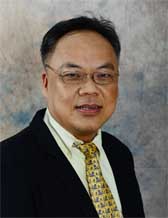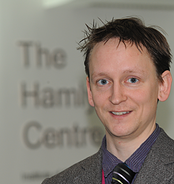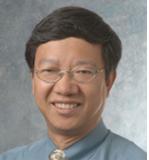
The 4th International Conference on Biomedical
Engineering and Biotechnology (ICBEB2015)
August 18th - 21st, 2015, Shanghai, China
• 中文版
• English

 |
Dr. Edward J. Ciaccio |
| Columbia University, USA | |
| Speech title: An LMS Algorithm for Characterization of BioSignal Shape Abstract: Shape is an important biomedical signal component which is often overlooked in feature extraction, signal classification, and matching schemes. Presently, simple statistical and syntactic metrics are often used to capture signal morphology, such as mean and variance calculation and peak-counting. However, the essence of signal shape is not well elucidated by these methods. It would therefore be useful to improve the calculation paradigm. A biomedical signal can be defined by its extrinsic shape (x-axis and y-axis shift and scale) and intrinsic shape (shape after normalization of extrinsic features). To increase efficacy for morphologic characterization, a least mean squares (LMS) algorithm can be implemented to adaptively seek optimal performance criteria using the method of differential steepest descent. Equations for normalization of x-axis and y-axis shift More... |
|
 |
Dr. Ng Yin Kwee |
| Nanyang Technological University, SG | |
| Speech title: Computer-Aided Diagnosis of Myocardial Infarction Using Ultrasound Images with Second-Order Statistics, DWT and HOS Methods: A Comparative Study Abstract:Myocardial Infarction (MI) or heart attack is the most common type of coronary heart disease (CHD) and is the leading cause of cardiac death worldwide. Precise and timely identification of MI and extent of muscle damage helps in early treatment and reduction in the time taken for further tests. MI diagnosis using 2D echocardiography is prone to inter/intra observer variability in the assessment. Therefore, a computerised scheme based on image processing and artificial intelligent techniques can reduce the workload of clinicians and improve the diagnosis accuracy. A Computer-Aided Diagnosis (CAD) of infarcted and normal ultrasound images will be useful for clinicians. More... | |
 |
Dr. Daniel Elson |
| Imperial College, London, UK | |
|
Speech title: Surgical Imaging, Biophotonics and Endoscopy Abstract:Surgical imaging describes the application of a range of imaging, vision and optical techniques to assist surgeons in intrasurgical decision making. In this talk I will describe how various biophotonics and optical imaging approaches may be adapted for surgical endoscopic application, including the use of multispectral imaging and polarization resolved imaging. Furthermore, the integration of these approaches with existing and new robotic platforms will be described, allowing improved ergonomics as well as better mechanical scanning of optical spectroscopic probes for more accurate optical diagnostics.A new approach for endoscopic structured lighting has also been developed for the detection of tissue surface curvatures during surgery. This work is driven by the need to provide a higher degree of control and vision for the surgeon, and to complement the standard white light reflection images. | |
 |
Dr. Zheng-Rong Lu |
| Department of Biomedical Engineering, Case Western Reserve University, Cleveland, Ohio, USA | |
|
Speech title: Early Detection and Treatment of Metastatic Breast Cancer Abstract:Early detection and diagnosis of high-risk cancer is critical in decision-making and tailoring effective treatment. Development of new therapeutics is essential to treat the patients diagnosed with high-risk cancer and to improve their survival and quality of life. Our lab is focused on translational development of new diagnostics and therapeutics for early detection and effective treatment of the diseases that impair and threaten human lives. We have designed and developed targeted Gd(III) based MRI contrast agents for detecting a biomarker associated with cancer metastasis and highly expressed in the extracellular matrix of malignant tumors. The targeted contrast agents specifically bind to the biomarker, resulting in high-resolution contrast enhanced molecular MRI of the tumors with a size as small as 0.5 mm and are effective for imaging and detection of micrometastases. We have also developed targeted multifunctional delivery systems to deliver therapeutic siRNAs to regulate the expression of disease related genes to effectively treat life-threatening diseases, including metastatic breast cancer. The targeted siRNA delivery system can effectively silence a target gene associated with breast cancer metastasis via systemic administration to prevent cancer progression and metastasis in mouse triple negative breast cancer models. | |
 |
David De Jong |
| University of São Paulo, Brazil | |
|
Speech title: The importance of scientific journals for advancement in biomedicine Abstract:Scientific journals are purveyors of knowledge. They divulge advancements in science in a way that both establishes credit for discovery and makes them available to other scientists and the public, who can use the new information. Technological advancement in all areas, including the health sciences, has helped man live better and longer. Making this knowledge available in an accessible and secure manner is a key part of this process. However, other aspects of the manner in which scientific journals deal with and transform submissions has a greater impact on how science is conducted than what is normally perceived by laymen, policy makers and even many scientists. Journal editorial boards evaluate manuscripts and those found to be potentially suitable are sent out for peer reviewer. Reviewers help determine if the research is original, pertinent, well conducted and worth publishing. They may find errors that if uncorrected would result in bad research being published that could confuse the field instead of adding useful knowledge. They also comment on the best ways to conduct research, helping the authors to improve their procedures and understanding of the field. They may point to pertinent publications unknown to the researchers that can affect or even completely change their conclusions. This process is not perfect, and mistakes are made. However, the process tends to be self correcting and has helped the health sciences advance considerably during the last 100 years. Scientists in third world countries also make important contributions, but many have difficulty publishing because of language and other limitations. Scientific journals in these countries, though often considered to be of less importance, have a key role because they help guide such authors through the publication process. These efforts should be recognized and facilitated so that research in these countries can advance and more effectively contribute to the health sciences worldwide. | |